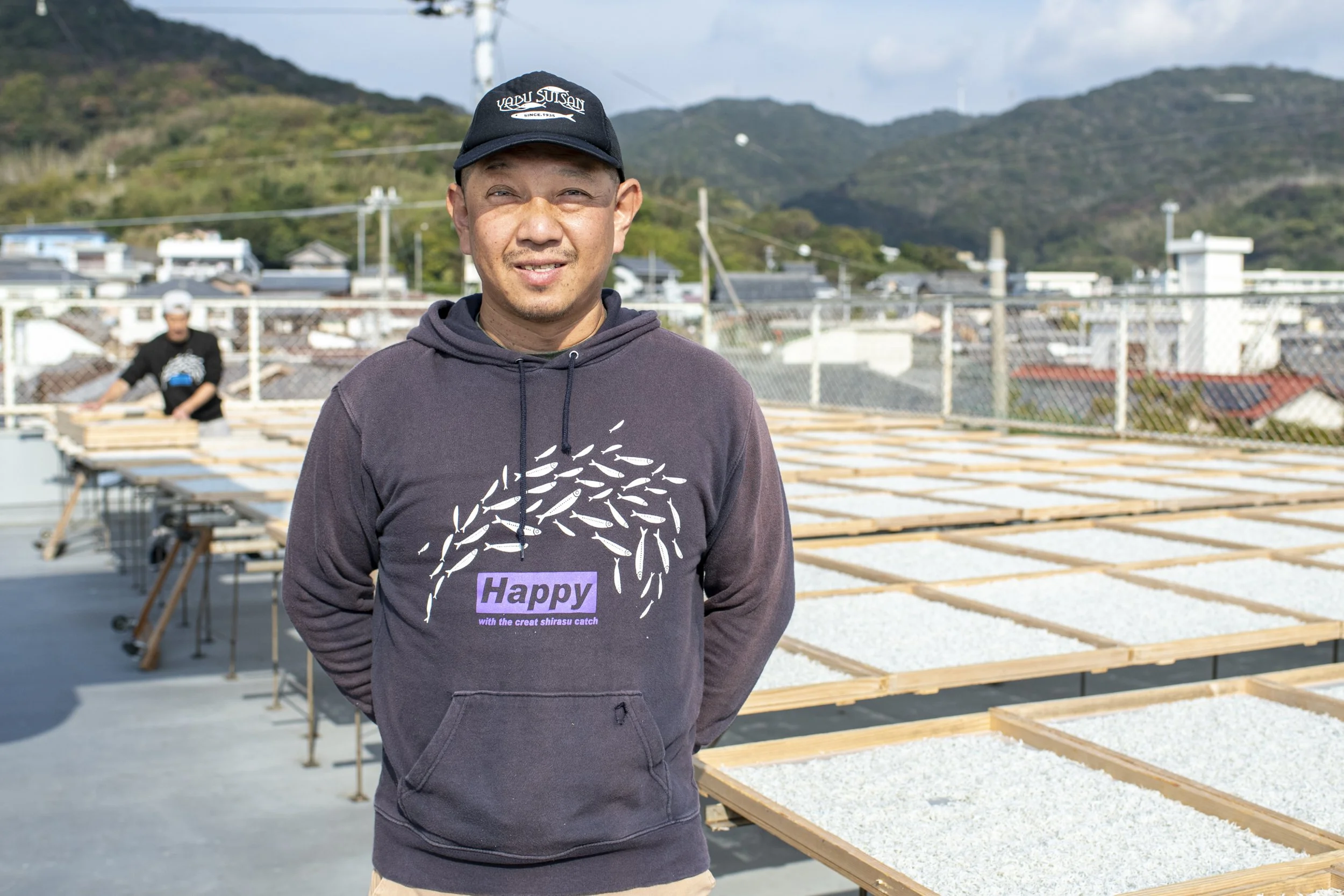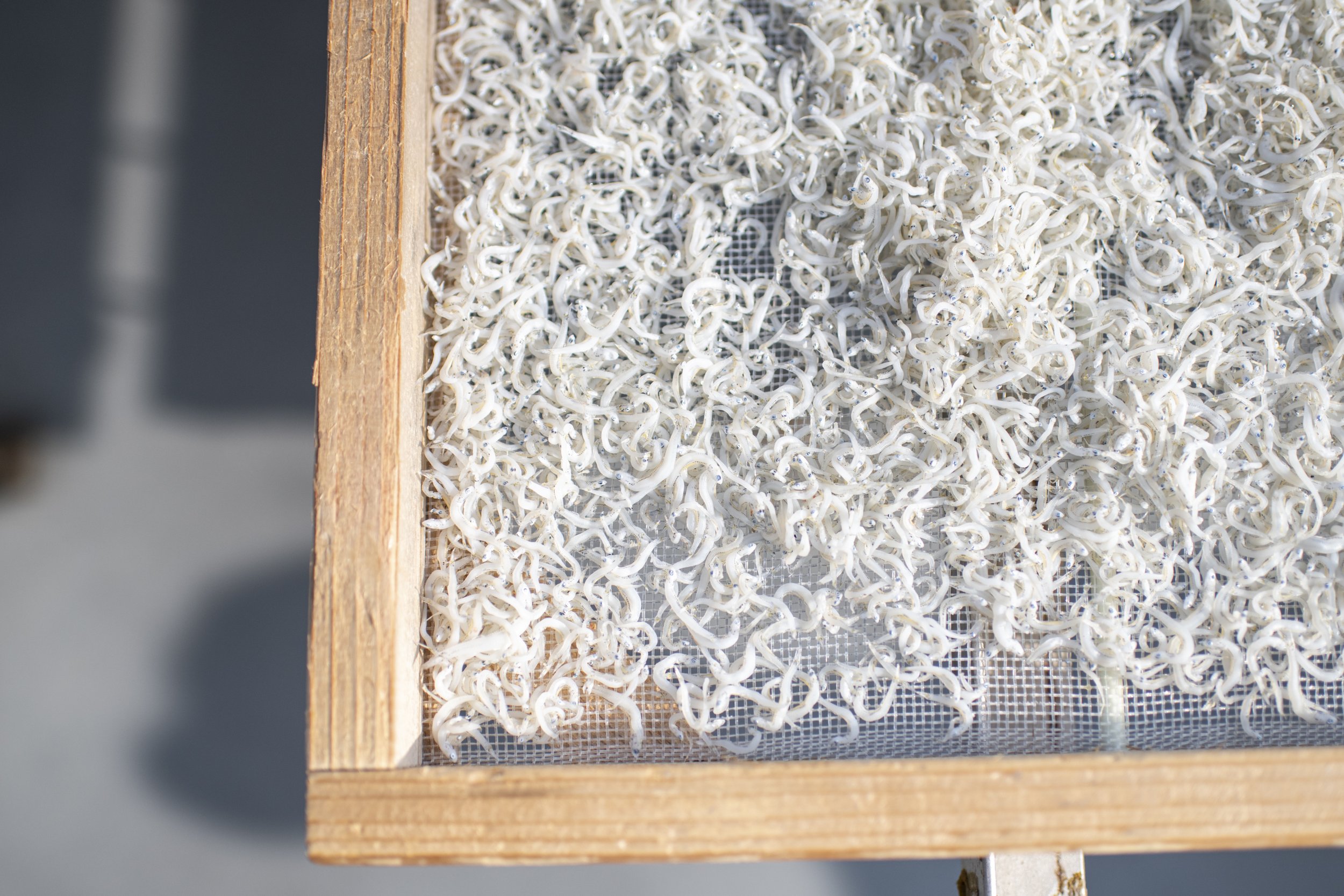Shirasu, Chirimen & Chirimen-Jako : Tiny Fish, Big Flavor
“Shirasu,” “chirimen,” and “chirimen-jako” are names used to describe tiny whitebait—usually a mixture of small baby anchovies (katakuchi-iwashi カタクチイワシ), sardines (ma-iwashi マイワシ), and herring (urume-iwashi ウルメイワシ). Caught and processed in large quantities, the whitebait is either sold raw, blanched, or blanched and dried. Raw shirasu in its semi-transparent state is considered a delicacy, but because of its extremely short shelf life, you need to go to restaurants and cafes near fishing ports that bring in whitebait to find good quality raw shirasu.
In the same way that whitebait is a jumbled mixture of fish varieties, untangling and defining the meaning of the terms “shirasu,” “chirimen,” and “chirimen-jako” is just as challenging. It’s not uncommon to hear these terms being used interchangeably, and people from the Setouchi and the Kansai regions of Japan (Osaka and its neighboring prefectures) sometimes refer to whitebait in all its forms as chirimen or chirimen-jako. Part of the confusion seems to come from regional differences in how soft they want their whitebait. People from eastern Japan (Tokyo and its environs, often referred to as Kanto) tend to prefer raw or very soft whitebait, whereas in the Setouchi and Kansai, there’s a clear preference for the harder, dried variety.
However, as a rule of thumb, we can draw a line in the sand and define “shirasu” as whitebait in its raw or lightly blanched state and “chirimen” and “chirimen-jako” as whitebait that has been blanched and dried to varying degrees of chewiness.
Workers wash the whitebait as soon as they unload the catch. Everything to do with shirasu and chirimen is a race against time to ensure the highest quality in the finished product.
Regardless of whether you prefer soft, melt-in-the-mouth, delicately briny shirasu or umami-rich, sun-dried chirimen, it’s undeniable that these tiny fish have been at the heart of Japanese and Setouchi cooking for millennia. You only have to look at the geography of the Setouchi to realize why dedicated chirimen factories hug the coastline throughout the region. The Seto Inland Sea’s warm climate combined with its enclosed, protected, shallow waters that flow into the Pacific Ocean and the Sea of Japan make the Setouchi a perfect nursery for tiny fish to flourish.
For centuries people in the Setouchi turned to shirasu and chirimen as both delicious ingredients and important sources of calcium (a heaping tablespoon of shirasu or chirimen contains as much calcium as a glass of milk but only half the calories), vitamin D, and DHA omega-3 oils. By drying the whitebait, they could lock in the antioxidants and omega-3 benefits that would disappear as the fresh fish deteriorated. It also intensifies its natural umami.
You can see just how important shirasu and chirimen are for Setouchi and Japanese cuisine in the myriad of ways these tiny fish are incorporated in recipes and used to garnish dishes. Whether simply heaped on grated daikon radish or a steaming bowl of white rice, or sprinkled on top of tofu or soba noodles, shirasu and chirimen shift seamlessly between being the protagonists of a dish to playing supporting roles.
Yabu Suisan Ltd. has been fishing for baby whitebait in the seas around Awaji Island in the eastern reaches of the Setouchi since 1935 and truck their catches all over Japan. They operate out of a quaint harbor town on the southern tip of the island called Fukura, where whitebait producers pack the shoreline in a stretch of coast affectionately known as “Chirimen Road.” During whitebait season, which runs from May to July and October to December, this quiet harbor becomes a hive of activity with boat engines spluttering, forklifts unloading crates of freshly caught whitebait, and racks upon racks of white, freshly blanched chirimen drying in the open air and the fresh sea breeze.
Because tiny whitebait deteriorate so quickly after being caught, speed is always of the essence. The fishing boats sail out at night and bring in their catches in the early hours. As soon as the boats arrive, the fish is unloaded, washed, blanched in boiling salted water, and swiftly dried on racks in the sun for an hour and a half. Yabu Suisan package and sell their chirimen au naturel or pre-cooked in the traditionally popular tsukudani sweet soy sauce glaze. They also add their own flourishes by offering chirimen mixed with chili peppers and sansho berries. According to Yabu Suisan’s current custodian Hisayoshi Yabu, their bumper whitebait catches in 2021 surpassed any in living memory. Good news for the rest of us who love using shirasu and chirimen in our Setouchi cooking.
Fishing boats along the “Chirimen Road” sail out of Fukura’s protected inlets to fish for whitebait in the waters around Awaji Island.
A worker is busy transporting empty racks into Yabu Suisan. This stretch of shoreline in Fukura Town is packed with chirimen producers.
Yabu Suisan やぶ水産
Otsu-1653-12 Fukura, Minamiawaji, Hyogo 656-0502
Tel: +81 (0799) 52 3132
Web: http://yabusuisan.com/
Yabu Suisan is situated along the “Chirimen Road” in the town of Fukura along with a number of whitebait fishing companies. Fukura is on the southern tip of Awaji Island, very near the famous Naruto whirlpools and the Awaji Puppet Theater. For the freshest, tastiest shirasu and chirimen, go to their premises between 8:30am and 4pm to buy directly at the source.
Where To Buy
Shirasu and chirimen are available in most supermarkets and department stores across Japan. You can find great local producers throughout the Setouchi. For a good selection of local Awaji Island shirasu and chirimen along with a huge selection of local produce, head to the newly opened Minacoicoiya Store (https://www.minacoicoiya.com). Address: 1408 Yagiyogikami, Minamiawaji, Hyogo 656-0443.
In the Setouchi and Kansai regions, it’s common to find chirimen prepared in a tsukudani sweet soy sauce glaze.
How To Use
The simplest way to enjoy fresh raw shirasu and semi-dried or dried chirimen is as a snack or appetizer served “as is” and enjoyed plain or finished with any number of condiments: a dash of soy sauce, a splash of ponzu sauce, touches of lemon juice and sea salt, or drizzled with sesame oil. It can also be mixed with finely grated oroshi daikon radish and then seasoned.
Somewhat similarly, it can be a whole meal. A classic Setouchi dish called Shirasu Don is a big handful of shirasu or chirimen heaped onto a bowl of white rice and finished with your choice of a variety of condiments: shiso leaves, chopped scallions, sesame seeds, or finely grated ginger and, again, seasoned with soy sauce or ponzu sauce.
Shirasu and chirimen, in turn, can be condiments for salads and vegetables, rice, and noodle dishes and as seasonings in all kinds of steamed, boiled, stir-fried, and braised dishes. Then, it’s typically added at the start of cooking, after first being lightly sauteed in oil to release its aroma and umami flavor.
As slightly salty, mild tasting protein loaded with calcium and umami, shirasu and chirimen can be thought of in terms of their culinary uses like cheese. Refreshingly light, mild-tasting, and creamy, raw shirasu has the qualities of fresh cheeses like ricotta or cottage cheese. Stronger-tasting, chewier semi-dried and fully-dried chirimen is more like hard cheeses, say even a Parmesan cheese. If you’re wondering why you would use shirasu or chirimen instead of cheese, that’s because they’re much lower in fat and calories and, therefore lighter, healthier ingredients. They also pair better with seafoods and with fresh, seasonal island cooking in general.









